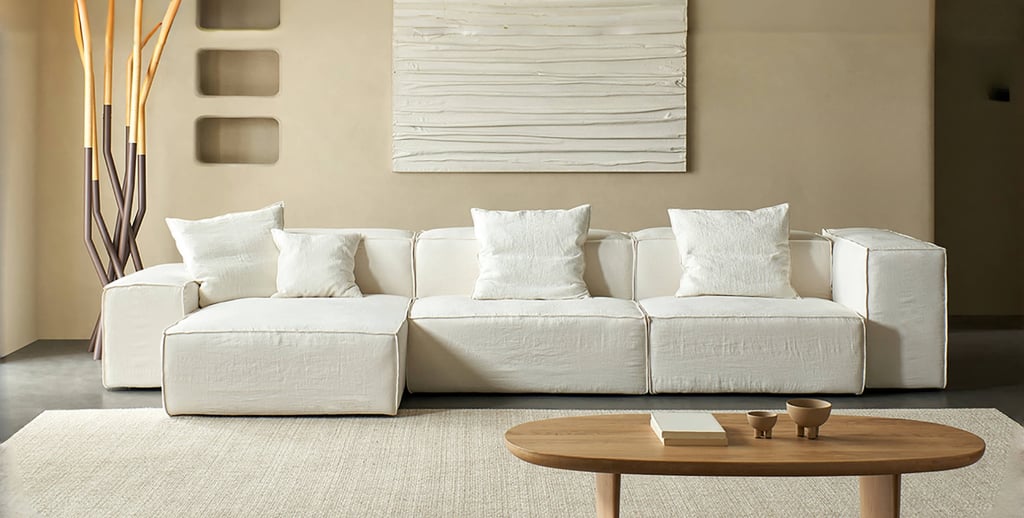Premium Linen Sofas Factory: Become Distributor & Retailer
Inside Scoop: Safety & Standards
Our Commitment At Linen World, exceptional quality means balancing luxury, longevity, and safety through our design ethos. We prioritize transparency about our production process so you can confidently welcome our pieces into your home. Rest assured: all products meet stringent legal safety standards—TB117-2013 and Prop 65—with rigorous testing for hazardous emissions. Everything falls within safe residential limits.
MATERIALS & CONSTRUCTION
Eryk Miao
7/3/20254 min read


Our Commitment
At Linen World, exceptional quality means balancing luxury, longevity, and safety through our design ethos. We prioritize transparency about our production process so you can confidently welcome our pieces into your home. Rest assured: all products meet stringent legal safety standards—TB117-2013 and Prop 65—with rigorous testing for hazardous emissions. Everything falls within safe residential limits.
Your Safety Questions Answered
Q:
What is Prop 65?
A California law requiring businesses to disclose products containing chemicals on its official hazardous substances list. While compliance is only mandatory in California, we test all products against this list. Our furniture contains negligible or zero traces of flagged chemicals (e.g., formaldehyde, phthalates like DEHP/DBP/BBP are absent). All items are fully Prop 65 compliant.
Q:
What is TB117-2013?
A federal flammability standard requiring upholstered furniture to pass a smolder test: a lit cigarette placed on fabric must self-extinguish before reaching cushion fill.
Q:
Do you use flame-retardant chemicals?
Yes, minimally and strategically. To pass TB117-2013:
We apply trace amounts of ammonium dihydrogen phosphate (ADP)—not a Prop 65-listed chemical—to inner layers (anti-poke fill casings and structural foam).
No chemical coatings (flame/water/stain repellents) are used on fabric surfaces.
Robust material layers prevent direct contact with flame retardants.
Q:
What are your foam and vegan poly fill made of?
Polyurethane (PUR) foam: Phthalate-free, Prop 65 compliant. Derived from petroleum-based polyols and isocyanates.
Vegan Poly Fiber: Made from PET (recyclable plastic used in bottles), fully compliant.
Q:
Do you use water or oil-based glues?
Oil-based glue: Bonds foam to frames (ensures lasting adhesion on uneven surfaces).
Water-based glue: Constructs wooden frames (sufficient for rigid materials).
Q:
Are your materials VOC-tested?
They sure are. We take extra care when evaluating our adhesives, foams, and frames for volatile organic chemicals (VOCs)—hazardous chemicals that manufactured items release into the air. Our materials are tested for toxic chemical emissions on the official Prop 65 list.
To give you a bit more context, these are the results of our VOC test by chemical:
Formaldehyde (Prop 65 compliant within a range less than or equal to .05 g/KG) : Not detected.
Benzol (Prop 65 compliant within a range less than or equal to 5.0 g/KG): Not detected.
Toluene + xylene (Prop 65 compliant within a range less than or equal to 150 g/KG): Not detected.
Dichloromethane (Prop 65 compliant within a range less than or equal to 50 g/KG): 30.2 g/KG detected.
Dichloromethane + triclosan + trichloroethylene (Prop 65 compliant within a range less than or equal to 5.0 g/KG): Not detected.
Q:
Does new furniture "off-gas"?
We get this question a lot, and it's a valid concern. Off-gassing occurs when a manufactured item releases hazardous chemicals into the air, specifically volatile organic chemicals (VOCs). Since all our products are Prop 65 compliant, you don't need to worry about the emission of harmful chemicals.
Truthfully, there are probably many items around your home that have the potential to off-gas—it is, to an extent, unpreventable. Certain paints, types of vinyl, insulation, even some air fresheners contain trace amounts of VOCs.
That's not to say that danger lurks all around you, and we certainly don't want to diminish the importance of keeping the chemicals in your home within a safe margin. But we do want to be transparent and provide as much context as possible when discussing the use of VOCs.
Again, Prop 65 is not federal law and furniture production is regulated differently than beauty products, electronics, cleaning products, children's toys, clothing, etc. Not all items in your home are Prop 65 compliant, nor are they required to be. We can only speak to what we use in our furniture and assure you that the few flagged chemicals fall within a range Prop 65 designates as safe, and often the range is too small to measure by Prop 65 standardized testing.
Q:
Why the chemical smell when unboxing?
Yes. Remember, your furniture just made a long journey across the ocean, wrapped up in a cardboard box—any noticeable odor results from material absorbing the smell of the packaging. If you do detect a scent, it will typically dissipate in a few days.
Off-gassing smells are commonly associated with mattresses, especially the kind that are vacuum-sealed and expand once you remove them from the box. That's because these items are essentially breathing for the first time when you open them.
Our products are, for the most part, made-to-order. Once constructed, they wait in our production facility—protected from the elements, of course—where they undergo quality checks and finishing touches. They have ample time to breathe before they're boxed up and shipped, and when we do pack them up, we wrap them just tightly enough to be secure. Any off-gassing that would theoretically occur would probably happen long before your item arrives. The same goes for our ready-to-ship products that live in our L.A. distribution center.
The Bottom Line
If a safety standard exists, we exceed it. Your furniture:
Won’t emit harmful chemicals (thanks to Prop 65 compliance).
Won’t pose fire risks (verified by TB117-2013 smolder tests).
Have concerns? Contact our team. We’re here to make you comfortable.
Resources
